Overview
- Brief Narrative
- Medal and ribbon commemorating the Anschluss of Austria by Nazi Germany.
- Date
-
commemoration:
1938 March 13
- Geography
-
issue:
Germany
- Credit Line
- United States Holocaust Memorial Museum Collection, Gift of Eugene Silver
Physical Details
- Language
- German
- Classification
-
Military Insignia
- Category
-
Medals
- Object Type
-
Medals, German (lcsh)
- Physical Description
- Circular, bronze colored metal medal attached at point to a grosgrain ribbon with a center red stripe, bordered by yellow, black, and yellow stripes. The front depicts two naked men, one holding a flag pole with a banner; the other is stepping onto a platform. embossed with the symbol of the Nazi eagle holding a wreath with a swastika inside. The reverse has German text around the edges.
- Dimensions
- overall: Height: 3.375 inches (8.573 cm) | Width: 1.500 inches (3.81 cm)
- Materials
- overall : metal, cloth, adhesive, thread
- Inscription
- reverse, swatike between each phrase, embossed : EIN REICH / EIN FÜHRER / EIN VOLK [ONE REICH / ONE FUHRER / ONE PEOPLE]
reverse, center, embossed : 13. / MÄRZ / 1938
Rights & Restrictions
- Conditions on Access
- No restrictions on access
- Conditions on Use
- No restrictions on use
Keywords & Subjects
- Topical Term
- National socialism--Austria.
Administrative Notes
- Legal Status
- Permanent Collection
- Provenance
- The Anchluss medal was donated to the United States Holocaust Memorial Museum in 2008 by Eugene Silver.
- Record last modified:
- 2023-08-31 10:43:58
- This page:
- https://collections.ushmm.org/search/catalog/irn36164
Download & Licensing
In-Person Research
- By Appointment
- Request 21 Days in Advance of Visit
- Plan a Research Visit
- Request to See This Object
Contact Us
Also in Eugene Silver collection
The collection consists of artifacts, documents, and photographs associated with the history of the Nazi Party in Germany from approximately 1933-1945.
Date: 1933-1945
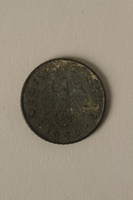
Nazi Germany, 5 reichspfennig coin
Object
5 reichspfennig [empire penny] coin, with 100 reichspfennig equalling 1 reichsmark, issued for use by the government of the Third Reich, Nazi Germany. From 1940-May 1945, when Germany surrendered and ended World War II in Europe, the coin was struck in zInc as a cost saving measure for the war, in all seven of the Reich mints.
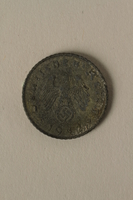
Nazi Germany, 5 reichspfennig coin
Object
5 reichspfennig [empire penny] coin, with 100 reichspfennig equalling 1 reichsmark, issued for use by the government of the Third Reich, Nazi Germany. From 1940-May 1945, when Germany surrendered and ended World War II in Europe, the coin was struck in zInc as a cost saving measure for the war, in all seven of the Reich mints.
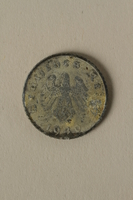
Nazi Germany, 5 reichspfennig coin
Object
5 reichspfennig [empire penny] coin, with 100 reichspfennig equalling 1 reichsmark, issued for use by the government of the Third Reich, Nazi Germany. From 1940-May 1945, when Germany surrendered and ended World War II in Europe, the coin was struck in zInc as a cost saving measure for the war, in all seven of the Reich mints.
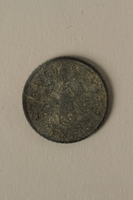
Nazi Germany, 5 reichspfennig coin
Object
5 reichspfennig [empire penny] coin, with 100 reichspfennig equalling 1 reichsmark, issued for use by the government of the Third Reich, Nazi Germany. From 1940-May 1945, when Germany surrendered and ended World War II in Europe, the coin was struck in zInc as a cost saving measure for the war, in all seven of the Reich mints.
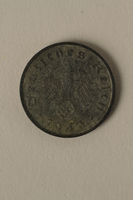
Nazi Germany, 10 reichspfennig coin
Object
10 reichspfennig [empire penny] coin, with 100 reichspfennig equalling 1 reichsmark, issued for use by the government of the Third Reich, Nazi Germany. From 1940-May 1945, when Germany surrendered and ended World War II in Europe, the coin was struck in zInc as a cost saving measure for the war, in all seven of the Reich mints.
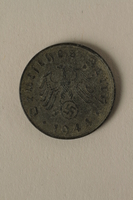
Nazi Germany, 10 reichspfennig coin
Object
10 reichspfennig [empire penny] coin, with 100 reichspfennig equalling 1 reichsmark, issued for use by the government of the Third Reich, Nazi Germany. From 1940-May 1945, when Germany surrendered and ended World War II in Europe, the coin was struck in zInc as a cost saving measure for the war, in all seven of the Reich mints.
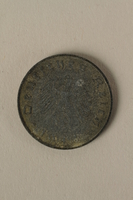
Nazi Germany, 10 reichspfennig coin
Object
10 reichspfennig [empire penny] coin, with 100 reichspfennig equalling 1 reichsmark, issued for use by the government of the Third Reich, Nazi Germany. From 1940-May 1945, when Germany surrendered and ended World War II in Europe, the coin was struck in zInc as a cost saving measure for the war, in all seven of the Reich mints.
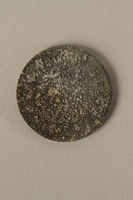
Nazi Germany, 10 reichspfennig coin
Object
10 reichspfennig [empire penny] coin, with 100 reichspfennig equalling 1 reichsmark, issued for use by the government of the Third Reich, Nazi Germany. From 1940-May 1945, when Germany surrendered and ended World War II in Europe, the coin was struck in zInc as a cost saving measure for the war, in all seven of the Reich mints.
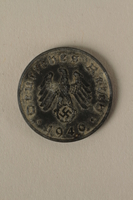
Nazi Germany, 10 reichspfennig coin
Object
10 reichspfennig [empire penny] coin, with 100 reichspfennig equalling 1 reichsmark, issued for use by the government of the Third Reich, Nazi Germany. From 1940-May 1945, when Germany surrendered and ended World War II in Europe, the coin was struck in zInc as a cost saving measure for the war, in all seven of the Reich mints.
Eugene Silver papers
Document
Consists of Nazi-related material from the collection of Eugene Silver. Includes cigarette cards, pre-war paper currency, photographs of SS training and of the German landscape and decor, photographs of a Nazi ceremony seemingly taken at FAG Kugelfischer (a fuel injection parts plant), an advertisement for a hotel in Coburg, and an ad to sell blank Nazi diaries/day planners for 1940.



